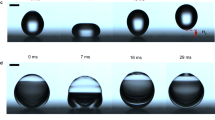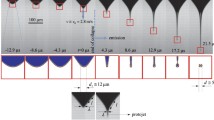Abstract
This paper aims to study a novel drop-on-demand droplet generation mechanism in which the oscillation and deformation of a non-equilibrium bubble in close proximity to a free surface induce an axisymmetric liquid spike on the free surface. The evolution of the liquid spike and its deformation due to the effect of surface tension force lead to the formation of a droplet. The free surface can be accorded by either a circular hole on a horizontal flat plate or by the top opening/nozzle of a vertical cylinder. A high-speed camera capable of obtaining images at a frame rate of 15,000 fps is utilized to observe the droplet formation process. Numerical simulations corresponding to the experiments are performed using the boundary integral spatial solution coupled with the time integration, i.e., a mixed Eulerian–Lagrangian method. In the experiments the bubble is generated using a very low voltage (only 55 V) in contrast to the relatively much higher voltages usually employed in reported works. This is very attractive from a safety viewpoint and accords great simplification of the setup. A comparison is made between the numerical and experimental results. A reasonable agreement has been found. The influences of the main design parameters, namely, the bubble-free surface distance and the dimension of the hole/nozzle on the bubble dynamics and on the droplet formation process are discussed and the conditions of the bubble dynamics under which a satellite-free droplet can be generated are sought. Furthermore, the effects of different geometries, namely, the horizontal flat plate and the vertical cylinder on the bubble dynamics and on the droplet features are examined. One important feature of the proposed actuation mechanism is the capability of producing droplets much smaller than the nozzle size. The possible applications of this mechanism are those where the accurate direction of the ejected droplet is of great importance such as inkjet printing.
Similar content being viewed by others
References
Tseng, F.G.: A micro droplet generation system. PhD thesis, UCLA, USA (1998)
Feng J.Q.: A general fluid dynamics analysis of drop ejection in drop-on-demand ink jet devices. J. Imaging Sci. Technol. 46, 398–408 (2002)
Wang, Y.: Applying drop-on-demand inkjet printing method to maskless lithography. PhD thesis, University of California at Berkeley, Berkeley (2005)
Chen P.H., Chen W.C., Chang S.H.: Bubble growth and ink jet ejection process of a thermal ink-jet printhead. Int. J. Mech. Sci. 39, 683–695 (1997)
Fromm, J.: A numerical study of drop-on-demand ink jets. In: Proceedings of the second international colloquium on drops and bubbles, NASA JPL Publication 82–7, California Institute of Technology, Pasadena (1982)
Allen R.R., Meyer J.D., Knight W.R.: Thermodynamics and hydrodynamics of thermal ink jets. Hewlett-Packard J. 36, 21–27 (1985)
Badie R., de Lange D.F.: Mechanism of drop constriction in a drop-on-demand inkjet system. Proc. R. Soc. London Ser. A 453, 2573 (1997)
Shin D.Y., Grassia P., Derby B.: Oscillatory incompressible fluid flow in a tapered tube with a free surface in an inkjet print head. ASME Trans. J. Fluids Eng. 127(1), 98–109 (2005)
Adams R.L., Roy J.: A one-dimensional numerical model of a drop-on-demand ink jet. J. Appl. Mech. 53, 193–197 (1986)
Shield T.W., Bogy D.B., Talke F.E.: Drop formation by DOD ink-jet nozzles: a comparison of experimental and numerical simulation. IBM J. Res. Dev. 31, 96–110 (1987)
Shin D.Y., Grassia P., Derby B.: Numerical and experimental comparisons of mass transport rate in a piezoelectric drop-on-demand inkjet print head. Int. J. Mech. Sci. 46, 181–199 (2004)
Fromm J.: Numerical calculation of the fluid dynamics of drop-on-demand jets. IBM J. Res. Dev. 28(3), 322–333 (1984)
Rembe C., Patzer J., Hofer E.P., Krehl P.: Realcinematographic visualization of droplet ejection in thermal ink jets. J. Imaging Sci. Technol. 40(5), 400–404 (1996)
Dong H., Carr W.W., Morris J.F.: An experimental study of drop-on-demand drop formation. Phys. Fluids 18, 072102 (2006)
Dong H., Carr W.W., Morris J.F.: Visualization of drop-on-demand inkjet: drop formation and deposition. Rev. Sci. Instrum. 77, 085101 (2006)
Aleinov, I.D., Sussman, M., Puckett, E.G.: Formation of droplets in microscale jetting devices, In: Proceedings of the 3rd ASME/JSME joint fluids engineering conference, San Francisco, CA (FEDSM99-7106), July 18–23 (1999)
Yu J.D., Sakai S., Sethian J.A.: A coupled quadrilateral grid level set projection method applied to ink jet simulation. J. Comp. Phys. 206(1), 227–251 (2005)
Yu J.D., Sakai S., Sethian J.A.: Two-phase viscoelastic jetting. J. Comp. Phys. 220(2), 568–585 (2007)
Asai A., Hara T., Endo I.: One-dimensional model of bubble growth and liquid flow in bubble jet printers. Jpn. J. Appl. Phys. 26(10), 1794–1801 (1987)
Asai A.: Three-dimensional calculation of bubble growth and drop ejection in a bubble jet printer. ASME J. Fluids Eng. 114, 638–641 (1992)
Xu Q., Basaran O.A.: Computational analysis of the drop-on-demand drop formation. Phys. Fluids 19, 102111 (2007)
Sakai, S.: Dynamics of piezoelectric inkjet printing systems. In: Proceedings of IS&T’s NIP 16: International conference on digital printing technologies, vol. 16, pp. 15–20. Vancouver BC, Canada (2000)
Blake J.R., Gibson D.C.: Growth and collapse of a vapour cavity near a free surface. J. Fluid Mech. 111, 124–140 (1981)
Pearson A., Cox E., Blake J.R., Otto S.R.: Bubble interactions near a free surface. Eng. Anal. Boundary Elem. 28, 295–313 (2004)
Wang Q.X., Yeo K.S., Khoo B.C., Lam K.Y.: Strong interaction between a buoyancy bubble and a free surface. Theor. Comput. Fluid Dyn. 8, 73–88 (1996)
Wang Q.X., Yeo K.S., Khoo B.C., Lam K.Y.: Nonlinear interaction between gas bubble and free surface. Comput. Fluids 25(7), 607–628 (1996)
Shima A., Takayama K., Tomita Y.: Mechanism of impact pressure generation from spark-generated bubble collapse near a wall. AIAA J. 21, 55–59 (1983)
Soh W.K., Shervani-Tabar M.T.: Computer model for a pulsating vapor bubble near a rigid surface. Comput. Fluid Dyn. J. 3(1), 223–236 (1994)
Chan P.C., Kan K.K., Stuhmiller J.M.: A computational study of bubble-structure interaction. J. Fluids Eng. 122, 783–790 (2000)
Yuan H., Oguz H.N., Prosperetti A.: Growth and collapse of a vapor bubble in a small tube. Int. J. Heat Mass Transf. 42, 3653–3657 (1999)
Shervani-Tabar M.T., Maghsoudi K.: Numerical study on the splitting of a vapour bubble in the process of EDM. Int. J. Adv. Manuf. Technol. 38, 657–673 (2008). doi:10.1007/s00170-007-1123-8
Nitsche M., Steen P.H.: Numerical simulations of inviscid capillary pinchoff. J. Comput. Phys. 200, 299–324 (2004)
Taib, B.B.: Boundary integral methods applied to cavitation bubble dynamics. PhD thesis, University of Wollongong, NSW, Australia (1985)
Abramowitz M., Stegun I.A.: Handbook of mathematical functions. Dover, New York (1965)
Hastings C.: Approximations for digital computers. Princeton University press, Princeton (1955)
Arfken G.B., Weber H.J.: Mathematical methods for physicists. Harcourt/Academic Press, New York (2001)
Longuet-Higgins M.S., Cokelet E.D.: The deformation of steep waves on water: I. A numerical method of computation. Proc. R. Soc. Lond. A 350, 1–26 (1976)
Best J.P., Kucera A.: A numerical investigation of non-spherical rebounding bubbles. J. Fluid Mech. 247, 137–154 (1992)
Dadvand A., Khoo B.C., Shervani-Tabar M.T.: A collapsing bubble-induced microinjector: an experimental study. Exp. Fluids 46, 419–434 (2009). doi:10.1007/s00348-008-0568-3
Buogo S., Cannelli G.B.: Implosion of an underwater spark-generated bubble and acoustic energy evaluation using the Rayleigh model. J. Acoust. Soc. Am. 111(6), 2594–2600 (2002)
Soh W.K., Willis B.: A flow visualization study on the movements of solid particles propelled by a collapsing cavitation bubble. Exp. Thermal Fluid Sci. 27, 537–544 (2003)
Lee M., Klaseboer E., Khoo B.C.: On the boundary integral method for the rebounding bubble. J. Fluid Mech. 570, 407–429 (2007)
Turangan C.K., Ong G.P., Klaseboer E., Khoo B.C.: Experimental and numerical study of transient bubble-elastic membrane interaction. J. Appl. Phys. 100, 054910 (2006)
Klaseboer E., Turangan C.K., Khoo B.C.: Dynamic behaviour of a bubble near an elastic infinite interface. Int. J. Multiph. Flow 32, 1110–1112 (2006)
Khoo B.C., Klaseboer E., Hung K.C.: A collapsing bubble-induced micro-pump using jetting effect. Sensor. Actuat. A-Phys. 118, 152–161 (2005)
Lew K.S.F., Klaseboer E., Khoo B.C.: A collapsing bubble-induced micro-pump: an experimental study. Sensor. Actuat. A-Phys. 133, 161–172 (2007)
Zhang Y.L., Yeo K.S., Khoo B.C., Wang C.: 3D jet impact and toroidal bubbles. J. Comp. Phys. 166, 336–360 (2001)
Wang, Q.X., Yeo, K.S., Khoo, B.C., Lam, K.Y.: Vortex ring modeling of toroidal bubbles. Theor. Comput. Fluid Dyn. 1–15 (2005). doi:10.1007/s00162-005-0164-6
Fong, S.W., Adhikari, D., Klaseboer, E., Khoo, B.C.: Interactions of multiple spark-generated bubbles with phase differences. Exp. Fluids (2008). doi:10.1007/s00348-008-0603-4
Tan K.L., Khoo B.C., White J.K.: A level set-boundary element method for the simulation of underwater bubble dynamics. SIAM J. Sci. Comput. 30(2), 549–571 (2008)
Author information
Authors and Affiliations
Corresponding author
Additional information
Communicated by M. Y. Hussaini
Rights and permissions
About this article
Cite this article
Shervani-Tabar, M.T., Dadvand, A., Khoo, B.C. et al. A numerical and experimental study of a collapsing bubble-induced droplet ejector. Theor. Comput. Fluid Dyn. 23, 297–316 (2009). https://doi.org/10.1007/s00162-009-0123-8
Received:
Accepted:
Published:
Issue Date:
DOI: https://doi.org/10.1007/s00162-009-0123-8




